Paradis Tide Gauge
18.43168 deg N, 72.76044 deg W
The tide gauge is installed at the Paradis Beach Club, Jeanty les Bains, Grand Guave, Haiti with the kind permission of its Confident, Jean Herold.phone 5606 9977. Transmissions from this gauge have been made possible by a generous gift from DataGarrison.com (Tom and Nazneen Stalcup). DataGarrison provide Iridium telemetry to the other four sites.
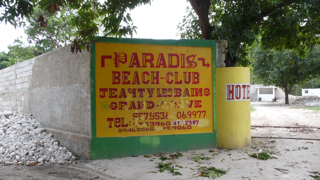
The pressure sensor is bolted to a foundation pier roughly 70 cm below mean sea level. The pressure port is surrounded by copper mesh and a porous foam filter contained within a 2 inch PVC pipe, 4 inches long, open at top and bottom. On 26 March the sensor lay about 20 cm below the gravel and cobble beach materials. Abraded coral limestone is exposed at about mean-sea-level nearby.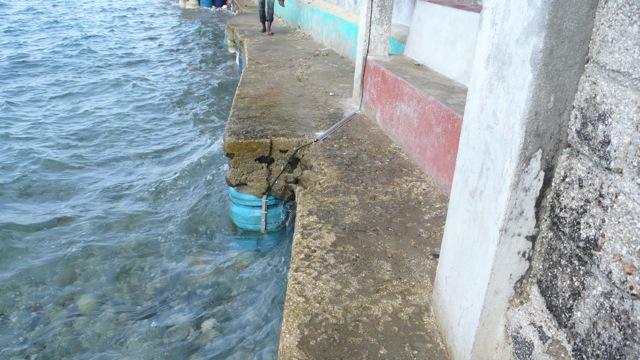 The pressure sensor is bolted to the base of a stainless steel bar which is bolted to a plastic coated concrete pillar.
The pressure sensor is bolted to the base of a stainless steel bar which is bolted to a plastic coated concrete pillar.
Data
The pressure port entry-filter reduces the amplitude of waves. Data are sampled every minute and a digital average recorded every 15 minutes. Data are transmitted every 2 hours via the Iridium satellite courtesy of Data Garrison, who have kindly waived transmission costs for 2010.
Recording started 26 March 2010 at approximately 2 pm. The figures below show the first three weeks of data from PARA (grey). By subtracting these data from GONA to the north we deduce that PARA is currently subsiding 1.2 mm/week. The data have not been corrected for wind stress.
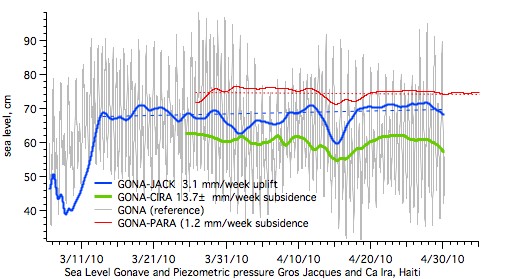
In the above figure we show two other differenced signals - GONA -Jack and GONA - CIRA . GONA-PARA provides the lowest noise difference signal of the three differenced signals perhaps because the two gauges measure sea level directly without piezometric filtering. The noisiest of these differenced signals is currently CIRA which is installed near to the mouth of a small stream.
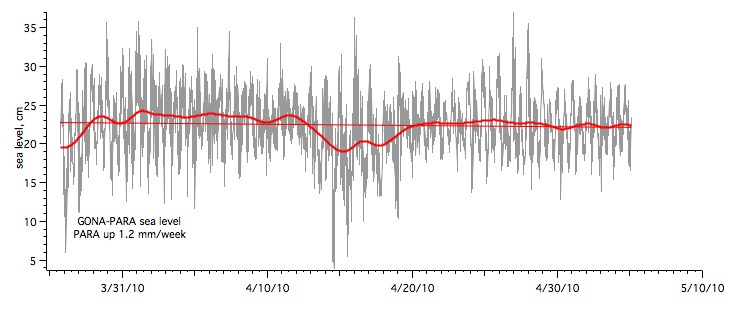
The above figure shows the raw differenced data from GONA minus PARA (grey), the filtered data, and a least squares fit to the data.
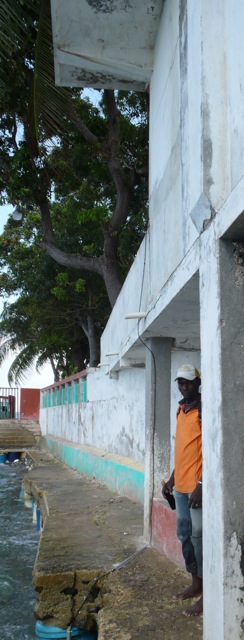 The pressure sensor is bolted to a blue concrete-filled foundation barrel (just in front of and below where Stanley Saintus is standing), and its cable bolted to the wall at intervals to the roof of the beach structure. The structure was mildly damaged in the earthquake (Intensity IX). The hotel structure had a few minor cracks but some parts of the Beach Club collapsed.
The pressure sensor is bolted to a blue concrete-filled foundation barrel (just in front of and below where Stanley Saintus is standing), and its cable bolted to the wall at intervals to the roof of the beach structure. The structure was mildly damaged in the earthquake (Intensity IX). The hotel structure had a few minor cracks but some parts of the Beach Club collapsed.